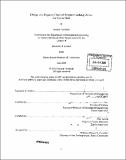| dc.contributor.advisor | David Wallace and Amy Smith. | en_US |
| dc.contributor.author | Vechakul, Jessica | en_US |
| dc.contributor.other | Massachusetts Institute of Technology. Dept. of Mechanical Engineering. | en_US |
| dc.date.accessioned | 2006-05-15T20:42:30Z | |
| dc.date.available | 2006-05-15T20:42:30Z | |
| dc.date.copyright | 2005 | en_US |
| dc.date.issued | 2005 | en_US |
| dc.identifier.uri | http://hdl.handle.net/1721.1/32966 | |
| dc.description | Thesis (S.B.)--Massachusetts Institute of Technology, Dept. of Mechanical Engineering, 2005. | en_US |
| dc.description | Includes bibliographical references (leaf 61). | en_US |
| dc.description.abstract | Charcoal made from bagasse, the fibrous remains of sugarcane production, has the potential to serve as an alternate cooking fuel in Haiti, where the reliance on wood has led to severe deforestation. Current production methods for charcoal briquettes range from laborious hand- forming to expensive industrial machinery. Thus, there is a need for an intermediate technology. This thesis describes the development of an affordable, locally manufacturable, briquette-making device that produces higher quality charcoal than hand-formed briquettes. The device is intended for small-scale briquette production in rural villages to supply charcoal to local markets. Since little is known about the materials properties and characteristics of bagasse charcoal, several production possibilities have been considered and evaluated. The most important finding during this process was that impact loading is more effective than steady compression because the required forces are not easily achievable by simple mechanisms. The final concept is a pile driver press, which uses a hammer to strike a metal piston and drive it into a tall channel to compact a column of charcoal. Several briquettes can be formed at once by using thin spacers to separate sections of charcoal within the channel. | en_US |
| dc.description.abstract | (cont.) A single channel prototype has been constructed as a proof-of-concept model. Cylindrical briquettes formed using this prototype had an average density of 0.29 g/cm3, and an average radial failure load of 390 N. Commercially available Kingsford charcoal had an average density of 0.80 g/cm3 and the compressive strength was 590 N. Although the hammered briquettes were not as strong as commercial charcoal available in the United States, they should still be able to withstand the loads imposed during transport in Haiti. More tests and refinement of the design are needed, but overall the pile driver press has great potential to eventually be adopted in Haiti as a small-scale briquette-making device. | en_US |
| dc.description.statementofresponsibility | by Jessica Vechakul. | en_US |
| dc.format.extent | 61 leaves | en_US |
| dc.format.extent | 8301712 bytes | |
| dc.format.extent | 8303458 bytes | |
| dc.format.mimetype | application/pdf | |
| dc.format.mimetype | application/pdf | |
| dc.language.iso | eng | en_US |
| dc.publisher | Massachusetts Institute of Technology | en_US |
| dc.rights | M.I.T. theses are protected by copyright. They may be viewed from this source for any purpose, but reproduction or distribution in any format is prohibited without written permission. See provided URL for inquiries about permission. | en_US |
| dc.rights.uri | http://dspace.mit.edu/handle/1721.1/7582 | |
| dc.subject | Mechanical Engineering. | en_US |
| dc.title | Design of a bagasse charcoal briquette-making device for use in Haiti | en_US |
| dc.type | Thesis | en_US |
| dc.description.degree | S.B. | en_US |
| dc.contributor.department | Massachusetts Institute of Technology. Department of Mechanical Engineering | |
| dc.identifier.oclc | 62860175 | en_US |
